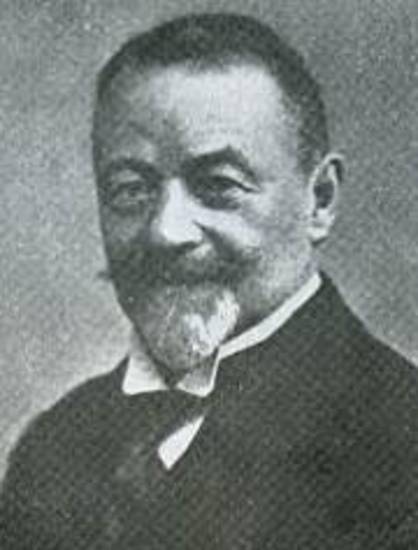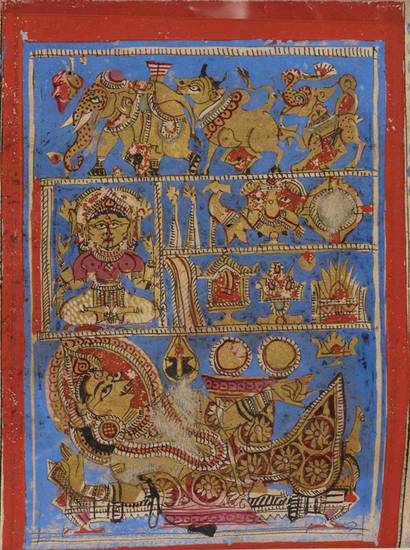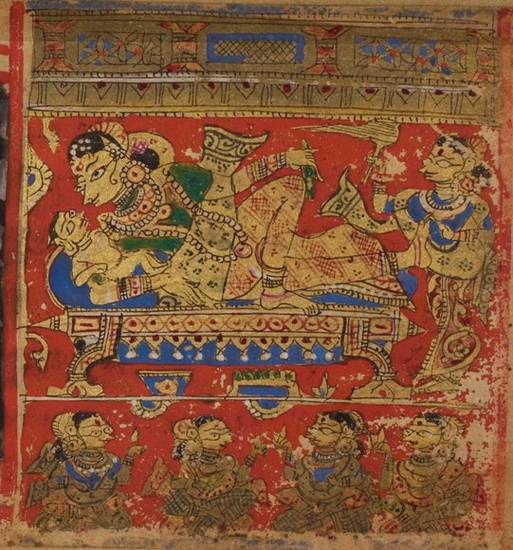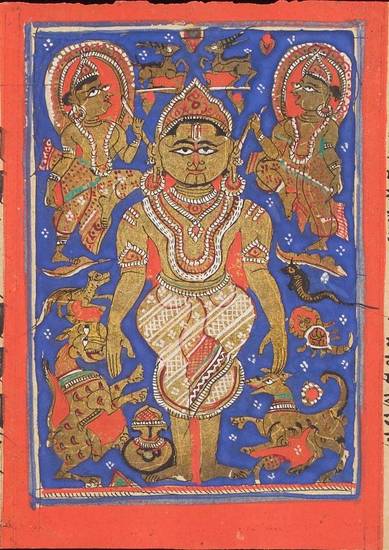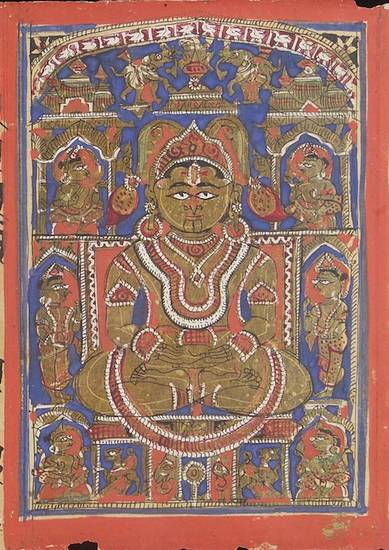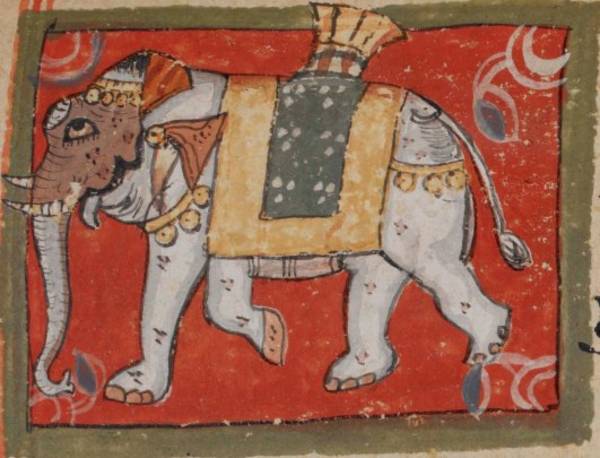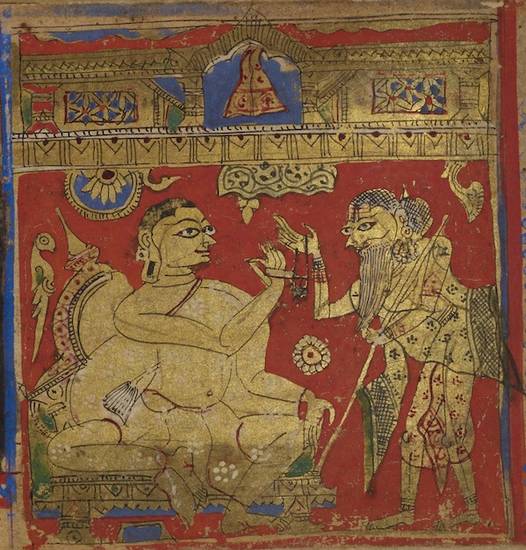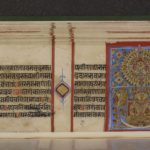Article: Kalpa-sūtra
The Kalpa-sūtra is a text in the Śvetāmbara canonical scriptures and one of the best-known, most fundamental Jain holy texts. Written in Ardhamāgadhī Prakrit, it is partly in prose and partly in verse.
A common name for the Kalpa-sūtra among Gujarati Jains is Bāraso-sūtra, meaning The Scripture of Twelve Hundred. The number of 1200 is rounded down from the 1216 sections that make up the sūtras when counted in the traditional way. However, its Prakrit title of Pajjosavaṇā Kappa comes from its vital part in a major festival among Śvetāmbara Jains.
Indeed, the text’s special importance and popularity comes largely from its association with the festival of Paryuṣaṇ, at the end of the rainy season. The Kalpa-sūtra has an important public and ceremonial role in this very significant festival. Copied annually for centuries as part of Paryuṣaṇ, there are numerous surviving manuscripts.
The Kalpa-sūtra is also important for its contents, set out in three parts. The first two parts contain details of the lives of the 24 Jinas, who are the source of Jain teachings, and their early followers. The third part establishes rules for monastic conduct during the rainy season, which is an exceptional period in the life of mendicants.
In addition, the Kalpa-sūtra is a key source for Jain art, because it is one of the most frequently illustrated Jain scriptures. Intended primarily as a way of passing on key episodes and themes of the text, Kalpa-sūtrapaintings have developed artistic conventions within a large body of work.
The scripture is closely linked with the Kālakācārya-kathā – Story of the Monk Kālaka. Though a separate text in its own right, this tale is frequently found at the end of manuscripts of the Kalpa-sūtra. The reasons for this are probably to do with the narrative of the monk’s life. Kālaka is credited with deciding the date of one of the days of Paryuṣaṇ and his story demonstrates qualities of the ideal ascetic. The latter point ties in with the Kalpa-sūtra theme of monks and nuns behaving correctly.
Appropriately for a fundamental Śvetāmbara scripture, the text is often found on manuscripts that are frequently noteworthy artefacts. JAINpedia has numerous digitised examples of the Kalpa-sūtra. Because of their beauty and importance in the literature and practice of the Jain faith, these items are highlights of the manuscripts on the website.
Creation of the Kalpa-sūtra
The Kalpa-sūtra is supposed to be the work of Bhadrabāhu. This highly respected figure is the centre of many legends and is an early religious teacher famous for his knowledge.
The date the Kalpa-sūtra was composed is unknown. Assuming Mahāvīra lived about 2,500 years ago and if Bhadrabāhu, who died about 162 to 175 years after him, is indeed the ‘author’, the work could date back to about 2,300 years ago. But there is no proof of this. It is likely that, as with all the Śvetāmbara canonical scriptures, the Kalpa-sūtra was passed on orally for centuries before being written down in the fifth century of the Common Era.
Kalpa-sūtra in the Śvetāmbara canon
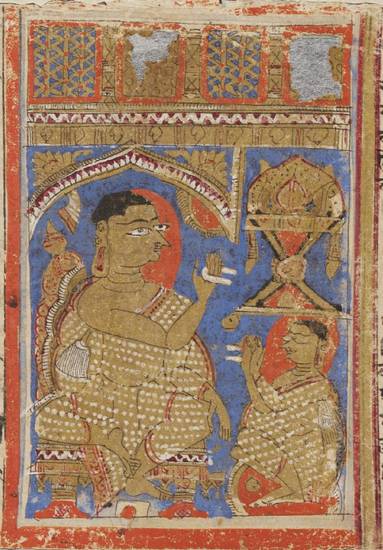
Teacher instructs a monk
Image by Victoria and Albert Museum © V&A Images/Victoria and Albert Museum, London
Counting the Kalpa-sūtra as one of the Śvetāmbara canonical texts emphasises the sections on monastic regulations. It belongs to the Cheda-sūtras, which include various works setting out the rules of behaviour in daily monastic life, compensations for lapses and so on. The Daśāśrutaskandha is one of these Cheda-sūtras and the Kalpa-sūtra forms its eighth chapter.
Although it is not an independent text, the Kalpa-sūtra has held a central position in the lives and hearts of Śvetāmbara Jains for many centuries.
Evidence from the 13th century
Sound evidence for the intense focus on the Kalpa-sūtra in the Śvetāmbara tradition is available from the 13th century onwards. There are plenty of commentaries on the text and hundreds of surviving manuscripts, copied as part of the annual festival of Paryuṣaṇ.
Commentaries
Firstly, numerous commentaries survive, written in both Sanskrit and vernacular languages, especially Gujarati. These commentaries aim:
- to make the original Prakrit text clearer by offering near-translations or retellings in languages that are more familiar to audiences
- to expand the original text by adding episodes or tales
- in some cases to use parts of the text to support sectarian views on doctrine or mythology.
Many commentaries on the Kalpa-sūtra are anonymous and amount to reading notes but it is significant that a good number is by religious teachers with a prominent place in their particular mendicant order. Two examples of many are:
- the Sandehaviṣa-auṣadhi or Remedy against the Poison of Doubt, completed in 1307 CE (1364 of the Vikrama era) by Jinaprabha-sūri of the Kharatara-gaccha and the oldest Sanskrit commentary on the Kalpa-sūtra
- the Kalpalatā or Garland of the Kalpa, by Samayasundara of the Kharatara-gaccha, written in the 17th century.
Annual copies
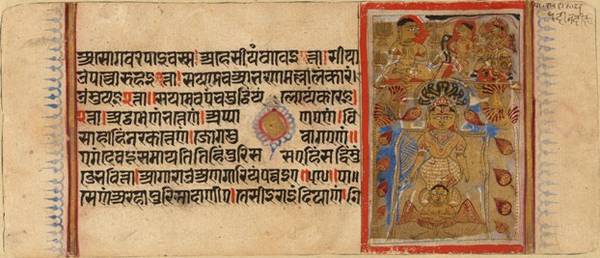
Typical manuscript painting
Image by Victoria and Albert Museum © V&A Images/Victoria and Albert Museum, London
Secondly, there was extensive copying of the Prakrit text of the Kalpa-sūtra and also the Prakrit text along with a commentary. These manuscripts are found in large numbers in all Śvetāmbara temple-libraries.
They often have remarkable features that make them more like objects of visual art, and which are not necessarily found in manuscripts of other texts. These characteristics are:
- painted paper creating a coloured background instead of plain yellowish paper, which may be identical throughout the manuscript or vary from one folio to the next
- the use of silver or golden ink instead of ordinary black ink
- a large square script providing rare examples of calligraphy in Jain manuscripts
- numerous miniature paintings, in the form of small vignettes (5 by 5 cm) or larger scenes (12 by 10 cm)
- the common use of detailed final colophons giving full information about the place, date and names of people involved in the process of copying.
The oldest illustrated manuscript of the Kalpa-sūtra known so far dates back to 1278 CE.
Kalpa-sūtra colophons frequently include members of the family or families who sponsored the copy, the name and monastic lineage of the religious teacher who asked them to sponsor and the names of individuals who are supposed to read the manuscript. Usually, the only information missing is the cost, but the fact that a Kalpa-sūtra manuscript often needed the sponsorship of more than one family shows that it was expensive.
Western ‘discovery’ of Jainism
The central importance of the Kalpa-sūtra was therefore established long before the 19th century, when Western observers or scholars gradually ‘discovered’ Jainism.
In 1807, Henry Thomas Colebrooke, the pioneering British scholar in all that relates to Sanskrit, and classical India in particular, described it ‘as a work of great authority among the Jainas’.
Reverend J. Stevenson published a translation of the Kalpa-sūtra in 1847. Although not very reliable, it is notable for being the first translation of any Jain text into English.
Hermann Jacobi was a German scholar who was one of the founding figures of Jain studies in the West. In 1879 he published his critical edition of the text and in 1884 the English translation followed. The introduction clearly demonstrates for the first time that Jainism is a fully independent tradition with its own scriptures and not an offshoot of Buddhism, as had been thought until then.
Centrality of the Kalpa-sūtra
There are two main grounds for the Kalpa-sūtra‘s occupying such a central position in Śvetāmbara Jainism. The principal reason is the content of the Kalpa-sūtra. Linked to this is the second reason – its role in worship, which focuses on both the meaning and the object itself.
Contents of the Kalpa-sūtra
The contents of the Kalpa-sūtra are foundations of Jain belief. To some extent, each of its three parts focuses on several things that define Śvetāmbara Jain identity and tradition.
Part One – ‘Lives of the Jinas’
The first part of the Kalpa-sūtra is called the ‘Jina-caritra’ or ‘Lives of the Jinas’. It consists of biographies of four of the 24 Jinas who are important figures of worship. They are, in order:
The lives of the remaining 20 Jinas are sketched much more briefly and are closer to outlines of key events than to narratives.
In the Śvetāmbara canonical scriptures, the ‘Jina-caritra’ can be described as the only complete text to focus on this topic in such a systematic and thorough manner. Other canonical scriptures, in contrast, merely provide clues to the Jinas’ careers. Two examples are:
- the Ācārānga-sūtra, the first book of the canon, where the ascetic career of Mahāvīra and the hardships he undergoes are depicted quite realistically
- the 22nd chapter of the Uttarādhyayana-sūtra, in which a famous episode dramatically relates how the 22nd Jina, Nemi, decides to renounce the world just before his wedding ceremony.
Given the status of the Jinas as religious teachers, the origin of Jain faith and role models, it is obviously important to have a single text providing fundamental material on them.
Part Two – ‘The String of Elders’

Jambū-svāmin and his eight wives
Image by Wellcome Trust Library © Wellcome Library, London
The second part of the Kalpa-sūtra is called ‘Sthavirāvalī’ or ‘The String of Elders’. Mostly in verse, it gives the history of early Jain teachers and helps to root the faith in solid ground. It provides a detailed list of names and short characterisations of a sequence of monks, starting with Mahāvīra’s disciples. It ends with Devarddhikṣamāśrmaṇa, who put the Śvetāmbara canonical scriptures in writing at the Valabhī plenary meeting in the 5th century.
As often in Indian religions, there is more to this list than appears at first sight. Listing the names of prestigious teachers displays respectful homage. Indeed, the last 13 stanzas of the ‘Sthavirāvalī’ show a high degree of reverence for the elders, taking the first person in the form ‘I bow down to X, Y, Z’. Thus the ‘Sthavirāvalī’ is a hymn of praise meant to be uttered by devotees, especially monks, to acknowledge their predecessors.
Part Three – ‘Right Monastic Conduct’
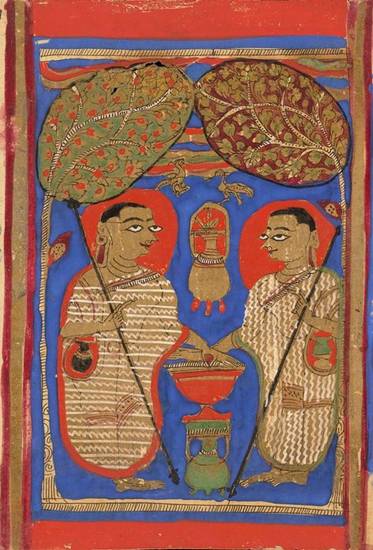
Rules on rainy-season alms
Image by Wellcome Trust Library © Wellcome Library, London
The third part of the Kalpa-sūtra is called ‘Sāmācārī’ or ‘Right Monastic Conduct’. This plainly demonstrates why the Kalpa-sūtra is included in the canonical Daśāśrutaskandha.
This section does not deal with monastic behaviour in general, but with monastic conduct during the rainy season. This usually lasts for four months, giving rise to the Sanskrit term cāturmāsa – ‘four months’ – and the Gujarati equivalent comāsa. These are the months from July to October.
The rainy season is a critical period of the year because vegetation and insects of all types thrive at this time. The division of the calendar year into rainy season and dry season is fundamental to all Indian religious communities. They have all evolved specific regulations for their members during the rainy season.
The basic rule during the rainy season is that Jain, and also Buddhist, ascetics should stop their wandering life and stay in one place. This primarily answers a common-sense and practical need. Monks and nuns travel only on foot, and walk barefoot, and roads and paths are simply unfit for walking during the often torrential rains. However, the main justification that is traditionally given is the fundamental concern for life and the desire to avoid all harm to life – ahiṃsā.
The ‘Sāmācārī’ of the Kalpa-sūtra sets out how monks and nuns of all ranks should behave in daily life during the heart of the rainy season. This is reckoned to be a month and 20 nights after the beginning of the rainy season. The ascetics should be more careful than ever about walking, eating, lying down and so on. They should be aware of all the minute forms of life that emerge and abound during this period, which implies more restrictions for the ascetics.
The special behaviours the mendicants should adopt are conveyed in the original text by the expression vāsā-vāsaṃ pajjosavei – ‘to perform the Pajjusana rites during rainy season’. This is the origin of the name Paryuṣaṇ, which is the title of the religious festival connected with this time of year.
Paryuṣaṇ and the Kalpa-sūtra
The instructions for Jain ascetics during the major festival of Paryuṣaṇ mainly explain the special place of the Kalpa-sūtra.
During the eight days of Paryuṣaṇ, the Kalpa-sūtra as a text and as an object is publicly worshipped among Śvetāmbara Mūrtipūjak Jains of Gujarat. This practice continues today.
In the past, the creation of illustrated or decorated manuscripts was sponsored for Paryuṣaṇ. Nowadays new printed editions with pictures in traditional or modern styles appear every year on this occasion.
Typically, on the third day of the festival, an auction takes place to decide which individual or family will present the new copy of the text to a local mendicant.
On the evening of the same day, the worshippers form a procession to take the copy to the home of the winning individual or family. It is worshipped with devotional songs and kept overnight.
On the fourth day the manuscript or book is presented publicly as an object of worship. Wrapped in muslin, it is placed in an embroidered wrapper and is sprinkled with sacred sandalwood powder – vāskṣep. It is placed on a metal or silver plate and ceremonially carried in procession to the temple hall where the mendicant sits.
Once in the hall, the book is worshipped as an embodiment of knowledge – jñāna – in a joyful atmosphere. Devotees present it with offerings of fruit, flowers, incense and sweets, waving lamps ritually before it.
From the fourth to the seventh day, ascetics read, recite or retell passages from the Kalpa-sūtra, usually in morning and afternoon sessions. This part of the ceremony depends on the mendicants’ abilities and tastes. It is important to note that in this context the term ‘Kalpa-sūtra’ means an ensemble combining the Prakrit text, Sanskrit and vernacular commentaries, and the free improvisation of the teaching mendicant.
On the eighth and last day, the book or manuscript is again the focus of worship. The monk reads the Prakrit text of the Kalpa-sūtra again, generally at a rather quick pace. At the same time, picture pages or independent illustrations are shown to the audience, acting as a visual commentary. This is important because the listeners mostly do not understand the literal words of the text in detail. However, they are familiar with the images, which are respected as objects of worship too.
Details of the ‘Lives of the Jinas’
The first part of the Kalpa-sūtra, called the ‘Jina-caritra’ or ‘Lives of the Jinas’, provides the main inspiration for illustrations in the text. It describes the lives of the four Jinas who are the primary figures of religious worship. The lives of the other 20 Jinas are outlined. All of the biographies follow a fairly strict pattern, including identical key points in the structure of the lives and repetition of individual phrases.
Mahāvīra’s life
First is the biography of Mahāvīra, the 24th and final Jina. All the life stories described in this section follow the same pattern. However, Mahāvīra is the only Jina whose life features the episode known as the ’embryo transfer’.
Conceived by Devānandā
In the incarnation before the last one, when he becomes a Jina, Mahāvīra is a god in the Puṣpottara heaven.
He begins his final rebirth in the womb of the brahmin lady Devānandā, who is married to the brahmin Usabhadatta.
Devānandā has the following 14 auspicious dreams:
- an elephant
- a bull
- a lion
- the goddess Śrī, who embodies prosperity
- a garland
- the moon
- the sun
- a banner
- a vase or jug
- a lotus lake
- the ocean
- a celestial abode
- a heap of jewels
- a flame or fire.
Devānandā tells her dreams to her husband, who explains that they mean the new baby will have outstanding physical and intellectual qualities. Devānandā is full of joy.
Śakra, the king of the gods, is sitting in his palace in the Saudharma heaven.
Knowing through his clairvoyance – avadhi-jñāna – that Mahāvīra has taken the form of a human embryo, Śakra is full of happiness and ready to pay homage to him. He utters an enthusiastic hymn of praise to the Jinas.
Embryo transfer
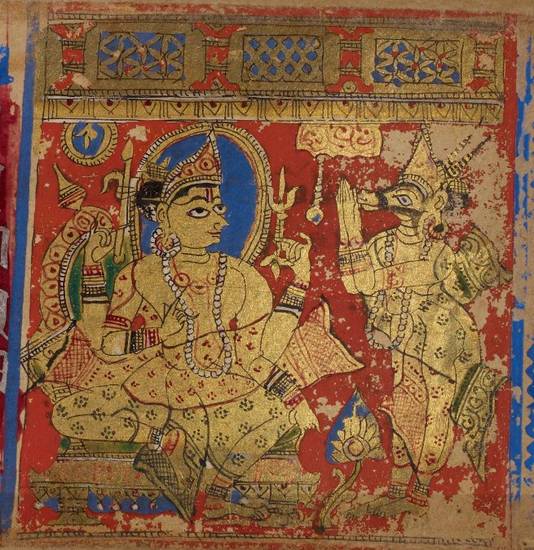
Śakra and Hariṇaigameṣin
Image by British Library © CC0 1.0 (Creative Commons Public Domain)
Then Lord Śakra realises that ‘it never happened, nor does it happen, nor will it happen, that arhats, cakravartins, baladevas or vāsudevas, in the past, present, or future should be born in low families, mean families… brahmanical families’.
They are always born in high, noble families, in families of kṣatriyas.
Thus he decides that the embryo of Mahāvīra must be removed from the brahmin lady Devānandā and placed in the womb of the kṣatriya lady Triśalā, wife of King Siddhārtha.
He calls Hariṇaigameṣin, the commander of his foot troops. Śakra orders him to transfer the embryo and then to report to him.
Hariṇaigameṣin accepts this order, magically transforms himself, enters Devānandā’s house at night, puts the whole household to sleep and removes Mahāvīra’s embryo from her womb.
He goes to the house of the kṣatriya couple, puts the whole household to sleep and implants Mahāvīra’s embryo in Triśalā’s womb. He takes the embryo she was carrying and transfers it to the brahmin lady. Then he reports to his master.
Trisala’s dreams
That same night the kṣatriya lady Triśalā has 14 auspicious dreams, the same as those of Devānandā. Each of them is described at length in the text.
Queen Triśalā goes to her husband Siddhārtha, wakes him up and describes her dreams.
Siddhārtha explains that they foretell the birth of a boy with outstanding physical and intellectual characteristics.
Triśalā stays awake the rest of the night to avoid having any bad dreams.
Before the day dawns, King Siddhārtha calls his servants. He tells them to get the hall of audience ready and to erect the throne.
At sunrise, Siddhārtha gets up and goes to the hall to do his physical training, in the form of jumping, wrestling and fighting. Afterwards servants rub him with oil, shampoo his hair and prepare him to enter the bathing room. After he has bathed, servants scent his body with perfume, arrange his hair and array him in rich ornaments. He puts on the insignia of kingship. He then sits on his throne, surrounded by dignitaries.
He summons the family servants and orders them to call for professional dream-interpreters.
After paying homage to Siddhārtha, the interpreters sit and answer the king’s questions about the 14 dreams. They confirm the outstanding qualities of the expected baby and predict that he will become either a universal emperor or a Jina. After delivering this news, they are dismissed politely.
The king reports the good news to his wife, who quietly retires to her own apartments.
Mahāvīra’s birth
From that night on, countless treasures of all sorts are brought to the palace by the various ranks of gods at Śakra’s request. From that night on, silver, gold and wealth go on increasing in the palace. Hence the king and his wife decide that the child they are expecting will be named Vardhamāna – ‘the Increaser’.
Out of compassion for his mother’s comfort, Mahāvīra decides to remain quiet without moving. Triśalā, thinking that the baby has died, is overwhelmed with sadness. She remains ‘reposing her head on her hand, overcome by painful reflections and casting her eyes on the ground’. Joy is silenced in the palace.
Becoming aware of this, Mahāvīra moves a little. Joy returns to his mother’s heart and to the palace.
Seeing the effect of his actions, Mahāvīra decides not to give up living in the world to become an ascetic as long as his parents are alive.
Triśalā’s pregnancy is spent as it should be, in peace and comfort. After nine months and seven and a half days, in the first month of summer, she gives birth to a perfectly healthy boy.
Celebrations of this blessed event last ten days. Prisoners are freed, taxes are lifted and so on. Legions of gifts are offered and a huge banquet is organised.
At the name-giving ceremony the child receives the name Vardhamāna from his parents. Later on he is also known as Śramaṇa – ‘Ascetic’ – and Mahāvīra – ‘Great Hero’.
Mahāvīra renounces
Mahāvīra has an elder brother, Nandivardhana, and a sister called Sudarśanā. He later marries a woman named Yaśodā.
At the age of 30, when his parents are no more, Mahāvīra seeks permission from his elder brother and gives up the worldly life to become an ascetic. His decision is celebrated by the gods.
The former prince renounces all his possessions and wealth, distributing presents to the poor.
Sitting on a palanquin, Mahāvīra is accompanied by gods and men who celebrate him. He proceeds in great pomp to the aśoka tree in the park of the city of Kuṇḍapura. Getting down from his palanquin, Mahāvīra removes all his ornaments and plucks out his hair in five handfuls. Thus he is a perfect renouncer.
Mahāvīra the mendicant
For the next year and one month the monk Mahāvīra wears clothes. After that he goes naked and uses the hollow of his hands to receive the food he begs as alms.
During the next 12 years Mahāvīra steadfastly overcomes all the tests of pain and the temptation of pleasures to which he is put by gods in disguise, demons or animals. The tests do not disturb his peace of mind. Throughout this time he is a perfect ascetic, leading a wandering life except during the rainy season.
During the 13th year he exposes himself to the heat of the sun and fasts for two and a half days with no water. Sitting in deep meditation under a sāla tree, he reaches omniscience.
Mahāvīra continues the wandering life of a mendicant, spending successive rainy seasons in various places. The total number of rainy seasons he experiences during his life as a monk is 42.
While spending the rainy season in the town of Pāpā – modern Bihar – Mahāvīra dies at the age of 72 and is liberated.
On the night he dies a great confusion arises. That very night his oldest and closest disciple, Indrabhūti Gautama, becomes omniscient.
On that night too, local kings light a great fire, saying: ‘Now the light of intelligence is gone, let us make light from ordinary materials’. This is how Jains explain the origin of the ‘Festival of Lights‘, called Dīvālī.
The community Mahāvīra founds during his lifetime has four parts.
|
Community part |
Leader |
|---|---|
|
14,000 monks |
Indrabhūti Gautama |
|
36,000 nuns |
|
|
159,000 male lay followers |
Śankhaśataka |
|
318,000 female lay followers |
The length of the different stages of Mahāvīra’s life is given at the end of the passage. He lives for a total of 72 years.
|
Stage |
Length |
|---|---|
|
30 years |
|
|
ordinary ascetic |
12 years |
|
omniscient ascetic |
30 years |
Pārśva’s life
The second life story in ‘Lives of the Jinas’ is that of Pārśvanātha or Lord Pārśva, the 23rd Jina.
In the incarnation before the last one, when he becomes a Jina, Pārśva is a god in the Prāṇata heaven.
He begins his final rebirth in the womb of Vāmā, wife of Aśvasena, King of Benares. Queen Vāmā has 14 auspicious dreams. After a quiet pregnancy, in due time she gives birth to a perfectly healthy boy. He is named Pārśva.
He lives for 30 years as a householder. Then gods arrive to witness his spiritual awakening.
The prince renounces all his possessions and wealth, and distributes presents to the poor. Sitting on a palanquin, he is accompanied by gods and men who celebrate him. He proceeds in great pomp to the aśoka tree in the park of the city of Benares. Getting down from his palanquin, Pārśva removes all his ornaments and plucks out his hair in five handfuls to become a monk. Thus he is a perfect renouncer.
For the next year and one month he wears clothes. After that he goes naked and uses the hollow of his hands to receive the food he begs as alms.
During the next 83 days Pārśva steadfastly overcomes all the tests of pain and the temptation of pleasures to which he is put by gods in disguise, demons or animals. The tests do not disturb his peace of mind. Throughout this time he is a perfect ascetic and leads a wandering life, except during the rainy season.
On the 84th day he exposes himself to the heat of the sun and fasts for two and a half days with no water. Sitting in deep meditation under a dhātakī tree, he reaches omniscience.
Pārśva has eight chief disciples – gaṇadhara – who lead one group of monks each. Their names are given in the text.
The community Pārśva founds has four parts.
|
Community part |
Leader |
|---|---|
|
16,000 monks |
Āryadatta |
|
38,000 nuns |
Puṣpacūlā |
|
164,000 male lay followers |
Suvrata |
|
327,000 female lay followers |
Sunandā |
The length of the different stages of Pārśva‘s life is given at the end of the passage. He lives for a total of 100 years.
|
Stage |
Length |
|---|---|
|
householder |
30 years |
|
ordinary ascetic |
83 days |
|
omniscient ascetic |
70 years |
Nemi’s life
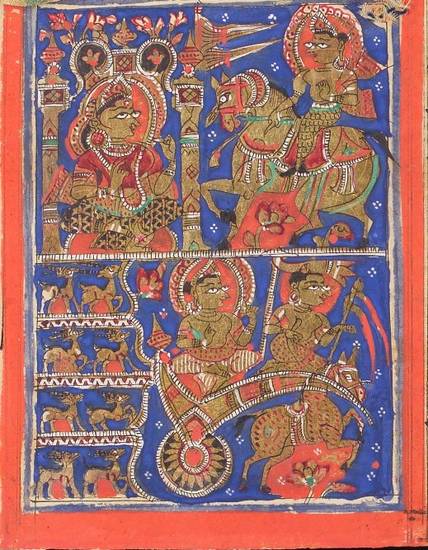
Nemi’s renunciation
Image by Wellcome Trust Library © Wellcome Library, London
The third story in ‘Lives of the Jinas’ describes the life of Ariṣṭaneminātha or Lord Ariṣṭanemi. The 22nd Jina is very often called Nemi.
In the incarnation before the last one, when he becomes a Jina, Nemi is a god in the Aparājita heavenly realm.
He begins his final rebirth in the womb of Queen Śivā, wife of Samudravijaya, King of Śauripura. Śivā has 14 auspicious dreams. After a quiet pregnancy, in due time she gives birth to a perfectly healthy boy. He is named Ariṣṭanemi.
Nemi lives for 300 years as a householder. Then gods arrive to witness his spiritual awakening.
The prince renounces all his possessions and wealth, and distributes presents to the poor. Sitting on a palanquin, he is accompanied by gods and men who celebrate him. He proceeds in great pomp to the aśoka tree in the park of the city of Dvāravatī. Getting down from his palanquin, Nemi removes all his ornaments and plucks out his own hair in five handfuls to become a monk. Thus he is a perfect renouncer.
For the next year and one month he wears clothes. After that he goes naked and uses the hollow of his hands to receive the food he begs as alms.
During the next 54 days Nemi steadfastly overcomes all the tests of pain and the temptation of pleasures to which he is put by gods in disguise, demons or animals. The tests do not disturb his peace of mind. Throughout this time he is a perfect ascetic and leads a wandering life, except during the rainy season.
On the 55th day Nemi exposes himself to the heat of the sun and fasts for two and a half days with no water. Sitting in deep meditation under a veṭasa tree on the summit of Mount Girnar, he reaches omniscience.
Nemi has 18 chief disciples – gaṇadhara – who lead one group of monks each. Their names are given in the text.
The community Nemi founds has four parts:
|
Community part |
Leader |
|---|---|
|
18,000 monks |
Varadatta |
|
40,000 nuns |
Āryā Yakṣiṇī |
|
169,000 male lay followers |
Nanda |
|
336,000 female lay followers |
Mahāsuvratā |
The length of the different stages of Nemi‘s life is given at the end of the passage. He lives for a total of 1000 years.
|
Stage |
Length |
|---|---|
|
householder |
300 years |
|
ordinary ascetic |
54 days |
|
omniscient ascetic |
700 years |
Lives of 20 Jinas
The next part of the ‘Lives of the Jinas’ covers 20 Jinas, from Naminātha or Lord Nami, the 21st, to Ajitanātha or Lord Ajita, the second. The aim of the text here is to give the number of years between each Jina. No episode of their individual lives is narrated.
Ṛṣabha’s life
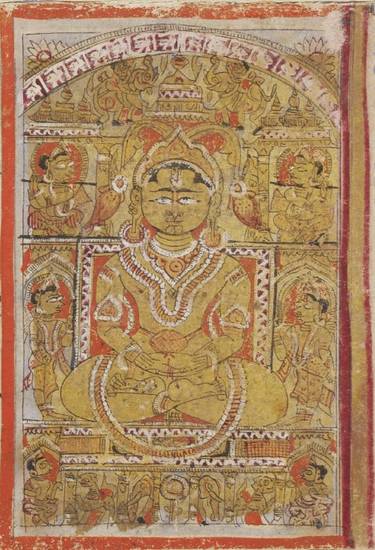
Worship of Ṛṣabha
Image by Victoria and Albert Museum © V&A Images/Victoria and Albert Museum, London
When the narrative of the ‘Lives of the Jinas’ reaches Ṛṣabha, the first Jina, it gives his full life story.
In the incarnation before the last one, when he becomes a Jina, Ṛṣabha is a god in the Sarvārtha-siddha heavenly kingdom..
He begins his final rebirth in the womb of Marudevī, wife of the patriarch Nābhi in Ikṣvāku-bhūmi. Marudevī has 14 auspicious dreams but the first one features the bull instead of the elephant. They are interpreted by Nābhi himself, without the help of dream-interpreters.
After a quiet pregnancy, in due time Marudevī gives birth to a perfectly healthy boy. He is named Ṛṣabha or ‘First King, First Mendicant, First Jina and First Tīrthaṃkara’.
Ṛṣabha lives for 2 million pūrvas as a prince and 6,300,000 pūrvas as a monarch. During his reign he teaches 72 arts, 64 feminine accomplishments, 100 crafts and 3 professions. He anoints his 100 sons as kings and gives a kingdom to each one. Then gods arrive to witness his spiritual awakening.
The king renounces all his possessions and wealth, and distributes presents to the poor. Sitting on a palanquin, he is accompanied by gods and men who celebrate him. He proceeds in great pomp to the aśoka tree in the Siddhārthavana park in the city of Vīnitā. Getting down from his palanquin, Ṛṣabha removes all his ornaments and plucks out his own hair in four handfuls to become a monk. Thus he is a perfect renouncer.
For the next year and one month he wears clothes. After that he goes naked and uses the hollow of his hands to receive the food he begs as alms.
During the next thousand years Ṛṣabha steadfastly overcomes all the tests of pain and the temptation of pleasures to which he is put by gods in disguise, demons or animals. The tests do not disturb his peace of mind. Throughout this time he is a perfect ascetic and leads a wandering life, except during the rainy season.
Then he fasts for three and a half days with no water. Sitting in deep meditation under a nyagrodha tree in Sakaṭamukha park outside the town of Purimatāla, he reaches omniscience.
Ṛṣabha has 84 chief disciples – gaṇadhara – who lead one group of monks each. Their names are given in the text.
The community Ṛṣabha founds has four parts.
|
Community part |
Leader |
|---|---|
|
84,000 monks |
Ṛṣabhasen |
|
300,000 nuns |
|
|
305,000 male lay followers |
|
|
554,000 female lay followers |
The length of different stages of Ṛṣabha’s life is given at the end of the passage. He lives for a total of 8,400,000 pūrvas.
|
Stage |
Detail |
Length |
|---|---|---|
|
householder |
8,300,000 pūrvas |
|
|
prince |
2,000,000 pūrvas |
|
|
king |
6,300,000 pūrvas |
|
|
ordinary ascetic |
1000 pūrvas |
|
|
omniscient ascetic |
99,000 pūrvas |
Illustrations in the Kalpa-sūtra
Though all pictures in manuscripts of the Kalpa-sūtra are next to the passage of text they illustrate, as per convention, the three parts of the Kalpa-sūtra are not treated equally in the pictorial tradition. The majority of paintings in a given manuscript focuses on the ‘Lives of the Jinas’, which offers a wide range of episodes to illustrate. The ‘String of Elders’ and the ‘Right Monastic Conduct’ sections, on the other hand, appear less inspiring to artists. As a result, they are either not illustrated at all or have a comparatively small number of paintings.
The paintings show that the term ‘Kalpa-sūtra’ is not merely a text but is better thought of as a dynamic notion that actively engages artistic and religious energies.
Paintings can be grouped into those depicting an episode that is:
- described in the adjacent original Prakrit text
- not in the facing original Prakrit text.
The subjects of the second group are drawn from the stories of the life of a Jina or an elder. These are found in other texts, namely the commentaries of the Kalpa-sūtra or other well-known legendary works devoted to these Jinas or these elders. These are used despite the fact that copies of the Kalpa-sūtra do not include a commentary.
Therefore the paintings that illustrate the Kalpa-sūtra are broader in scope than might be supposed, since they use the given text as a starting point and go beyond its literal content.
Repetition as a structuring pattern
Repetition is heavily used in the Kalpa-sūtra in both text and illustration.
The outline of the first part of the Kalpa-sūtra given above closely follows the Prakrit text, clearly demonstrating how each biography follows the same pattern. In many passages about individual Jinas the structure is the same. An example of identical structure is information about a Jina’s community. Only details differ, such as the various numbers and names. This is a fundamental pattern in Jain narrative literature. However, some passages that are almost identical in the life stories of Mahāvīra and Ṛṣabha show signs of being shortened.
The repetition in the text is also found in its illustrations, with the same picture often appearing in different places. The common episodes in Jinas’ lives that often share an identical depiction in the manuscripts include:
- the heavenly birth of the Jina-to-be
- the 14 auspicious dreams of the pregnant mother of the Jina-to-be
- each Jina plucking out his hair in handfuls when he renounces the world.
Before his last incarnation as a human being destined to become a Jina, the Jina-to-be is born as a god in one of the many heavens of the Upper World. Any difference in the pictures of the various heavenly births is found in the colour the body is painted. For example, gold is used for Mahāvīra and green for Pārśva. Each Jina has a colour associated with him in art.
The symbolic gesture of keśa-loca in the initiation ceremony may be depicted once in the manuscript, for only some of the Jinas or for all of them.
Thus, the paintings of the Kalpa-sūtra manuscripts are partly stereotyped. In mediocre manuscripts, they can become monotonous.
Creative inspirations
The tendency to copy paintings and reuse them at different points in the same manuscript is counterbalanced in various ways. Kalpa-sūtra manuscripts contain two types of illustrations. The first type is made up of those that show exactly what the text describes. The second kind of painting is a non-literal picture. Drawing on sources other than the Kalpa-sūtra proper, these pictures indicate wider knowledge about the episodes in the text. These illustrations may use passages in the Kalpa-sūtra text as an inspiration or bring into play information in other texts.
Kalpa-sūtra manuscripts often have paintings that depict literally the words in the adjacent sentences. Examples of this are the words:
- ‘the first dream of an elephant’ alongside a painting of an elephant
- ‘Triśalā is sad because she thinks the embryo she is carrying has died’ by a picture of Triśalā looking sad
- ‘Triśalā is happy because the embryo has moved again’ near an image of a joyful queen.
However, in most Kalpa-sūtra manuscripts there are also many examples of paintings that do not illustrate the literal words of the text. For artists, the Kalpa-sūtra is not only the Prakrit text but also the commentaries and other works on the lives of the Jinas or early Jain teachers. These writings have much more material suitable for illustration and artists draw freely on them.
There are two main types of non-literal illustrations. The first is when a sentence in the facing text provides a starting point. An example can be given using the following quotation:
For more than twelve years the Venerable Ascetic Mahāvīra neglected his body and abandoned the care of it; with equanimity he bore, underwent and suffered all kinds of pleasant or unpleasant occurrences arising from divine powers, men, or animals
This results in a picture of specific events illustrating the idea in the text, that is, the ‘attacks’ or ‘tests’ – upasargas – Mahāvīra goes through. Among them is the episode of the shepherd who tries to hurt Mahāvīra’s ears by putting spikes in them, or others where various devilish creatures try to attack him in various ways.
Another example is the paintings of incidents in the unsettled life of the early religious teacher Sthūlabhadra. None of them is described in the Kalpa-sūtra itself, but Sthūlabhadra’s name occurs in the ‘String of Elders’. This is reason enough to include pictures of his adventures, which, again, are well known from other textual sources and belong to the common Jain heritage.
Therefore, although there is a textual basis to such illustrations, it is outside the Prakrit text of the Kalpa-sūtra proper. However, this makes no difference to the artists.
The second type of non-literal picture is when the text does not provide any obvious inspiration for the illustration.
Examples include the paintings depicting episodes from Mahāvīra’s childhood, such as:
- going to school on the back of an elephant or horse
- playing with other children and showing how he can neutralise bad tricks or attacks.
Therefore Kalpa-sūtra manuscripts contain a variety of paintings. Some depict literally episodes in the text proper while others illustrate events taken from related literature.
Styles of painting
Kalpa-sūtra paintings may demonstrate all types of artistic style. However, there are two prevailing styles – the ‘classical’ and the ‘popular’.
The classical Western Indian style is easily recognisable thanks to the rigid conventions of:
- red background
- figures with typically protruding eyes
- monks and nuns in stereotyped white clothing with white or golden dots.
The ‘popular’ style has no such stylistic traditions and seems to show more freedom in the colours and in the realism of clothing, faces and so on.
Story of Kālaka
Examining manuscripts of the Kalpa-sūtra shows that it is closely associated with the story of the monk Kālaka or Kālakacārya. Some Jain authors of medieval times claim this connection is vital. All early manuscripts of the Kalpa-sūtra, they say, also have the story of Kālaka (Dundas 2007: n. 10). Both texts are considered to have equal authority for Śvetāmbaras.
The Story of Kālaka is known in several Sanskrit, Prakrit and Gujarati versions from the 12th century. It serves as a starting point for illustrations in manuscripts of the Kalpa-sūtra, where it follows the main scripture or is supported independently.
There are two main reasons for the connection between the Kalpa-sūtra and the Kālakācāryakathā or Story of Kālaka. The first is the influence of the early religious teacher or sūri, Kālaka, on the date of the festival of Paryuṣaṇ. The second is the tale of Kālaka himself, who wields great power because of his spirituality, which he uses for good. Certain elements of his life story are similar to those in the biographies of the Jinas, which are related in the first part of the Kalpa-sūtra.
Kālaka and Paryuṣaṇ
The monk Kālaka is closely linked to Paryuṣaṇ, which gives a central role to the Kalpa-sūtra. According to tradition he fixed the date of the final day of this festival, which became known as Saṃvatsarī.
Saṃvatsarī is the day of the festival on which the whole community practises pratikramaṇa – general repentance for breaking Jain regulations. Originally, in Mahāvīra’s time, it took place on the fifth night of the light half of the month Bhādrapada, which is roughly the four weeks from mid-August to mid-September. Under Kālaka’s authority this became the fourth night.
This change in a Paryuṣaṇ ceremony is supposed to have been introduced in 466 at the behest of King Śātavahana, to avoid a clash with a Hindu festival. Although this change is said in earlier sources to have met general approval, there is also evidence to show that it became a controversial and sectarian issue (see Dundas 2007 for more details).
In the course of his wandering life, Kālaka comes to the city of Pratiṣṭhāna in Mahārāṣṭra. King Śālivāhana welcomes the monk enthusiastically.
In due time the Paryuṣaṇa season arrived. There in the land of Mahārāṣṭra, on the fifth [night] of the bright half of the month [of] Bhādrapada, a festival of Indra took place. Then the king made representation to the sūri, “Reverend sir, on the day when the Paryuṣaṇā falls, there is to be a celebration by procession for Indra, in accordance with the custom of the folk. For that reason there will be so much confusion that I shall not be able to worship, bathe and otherwise honour the images of the Jinas. Therefore be so very kind as to celebrate the Paryuṣaṇā on the sixth.”
Then the reverend monk said, “…the Paryuṣaṇā may not come later than the night of the fifth. For it is said in the Scripture [Kalpa-sūtra]: ‘As the reverend Mahāvīra, when a month and 20 nights of the rains had passed, observed the Paryuṣaṇā, so too the Gaṇadharas …; as our masters, so too we observe the Paryuṣaṇā: it must not come later than that night.’”
The king said, “If that is so, then let it come on the fourth.”
The sūri answered, “So be it! There is no harm in that.”
Styles of painting
Kalpa-sūtra paintings may demonstrate all types of artistic style. However, there are two prevailing styles – the ‘classical’ and the ‘popular’.
The classical Western Indian style is easily recognisable thanks to the rigid conventions of:
- red background
- figures with typically protruding eyes
- monks and nuns in stereotyped white clothing with white or golden dots.
The ‘popular’ style has no such stylistic traditions and seems to show more freedom in the colours and in the realism of clothing, faces and so on.
Story of Kālaka
Examining manuscripts of the Kalpa-sūtra shows that it is closely associated with the story of the monk Kālaka or Kālakacārya. Some Jain authors of medieval times claim this connection is vital. All early manuscripts of the Kalpa-sūtra, they say, also have the story of Kālaka (Dundas 2007: n. 10). Both texts are considered to have equal authority for Śvetāmbaras.
The Story of Kālaka is known in several Sanskrit, Prakrit and Gujarati versions from the 12th century. It serves as a starting point for illustrations in manuscripts of the Kalpa-sūtra, where it follows the main scripture or is supported independently.
There are two main reasons for the connection between the Kalpa-sūtra and the Kālakācāryakathā or Story of Kālaka. The first is the influence of the early religious teacher or sūri, Kālaka, on the date of the festival of Paryuṣaṇ. The second is the tale of Kālaka himself, who wields great power because of his spirituality, which he uses for good. Certain elements of his life story are similar to those in the biographies of the Jinas, which are related in the first part of the Kalpa-sūtra.
Kālaka and Paryuṣaṇ
The monk Kālaka is closely linked to Paryuṣaṇ, which gives a central role to the Kalpa-sūtra. According to tradition he fixed the date of the final day of this festival, which became known as Saṃvatsarī.
Saṃvatsarī is the day of the festival on which the whole community practises pratikramaṇa – general repentance for breaking Jain regulations. Originally, in Mahāvīra’s time, it took place on the fifth night of the light half of the month Bhādrapada, which is roughly the four weeks from mid-August to mid-September. Under Kālaka’s authority this became the fourth night.
This change in a Paryuṣaṇ ceremony is supposed to have been introduced in 466 at the behest of King Śātavahana, to avoid a clash with a Hindu festival. Although this change is said in earlier sources to have met general approval, there is also evidence to show that it became a controversial and sectarian issue (see Dundas 2007 for more details).
In the course of his wandering life, Kālaka comes to the city of Pratiṣṭhāna in Mahārāṣṭra. King Śālivāhana welcomes the monk enthusiastically.
In due time the Paryuṣaṇa season arrived. There in the land of Mahārāṣṭra, on the fifth [night] of the bright half of the month [of] Bhādrapada, a festival of Indra took place. Then the king made representation to the sūri, “Reverend sir, on the day when the Paryuṣaṇā falls, there is to be a celebration by procession for Indra, in accordance with the custom of the folk. For that reason there will be so much confusion that I shall not be able to worship, bathe and otherwise honour the images of the Jinas. Therefore be so very kind as to celebrate the Paryuṣaṇā on the sixth.”
Then the reverend monk said, “…the Paryuṣaṇā may not come later than the night of the fifth. For it is said in the Scripture [Kalpa-sūtra]: ‘As the reverend Mahāvīra, when a month and 20 nights of the rains had passed, observed the Paryuṣaṇā, so too the Gaṇadharas …; as our masters, so too we observe the Paryuṣaṇā: it must not come later than that night.’”
The king said, “If that is so, then let it come on the fourth.”
The sūri answered, “So be it! There is no harm in that.”
- +
- aAbhavya
- aAbhinandana
- aAbhiṣeka
- aĀcāra
- aĀcārāṅga-sūtra
- aĀcārya
- aAchalbhrata
- aAḍhāī-dvīpa
- aAdharma
- aAdho-loka
- aAdhyayana
- aAdvaita Vedānta
- aĀgama
- aAghātīya
- aAghātīya-karman
- aAgnibhuti
- aAgra
- aĀhāra
- aAhiṃsā
- aAhimsa Day
- aAjita
- aAjīva
- aAkampit
- aĀkāśa
- aAkbar the Great
- aAkṣaya-tṛtīyā
- aAlauddin Khalji
- aAlbert Einstein
- aAllah
- aAlms
- aĀlocanā
- aAloka-ākāśa
- aAmāri
- aAmbikā or Kūṣmāṇḍinī
- aAnagāra
- aAnanta
- aAnarthadaṇḍa
- aAnaśana
- aAnekānta-vāda
- aAṅga
- aAniconism
- aAnojjā
- aAntarāla
- aAntarāya-karma
- aAṇu
- aAṇu-vrata
- aAnukampā
- aAnuprekṣā
- aAnusvāra
- aApabhraṃśa
- aAparigraha
- aAra
- aĀrambha
- aĀrambhaja
- aĀratī
- aArdhamāgadhī Prākrit
- aArhaṃ
- aArhat
- aArśana-āvaraṇīya-karma
- aĀrta-dhyāna
- aĀryikā
- aĀryikā Jñānamati
- aĀśātanā
- aĀścarya
- aAscetic
- aAsceticism
- aAshram
- aAspiration
- aĀsrava
- aAṣṭa-maṅgala
- aAṣṭāpada
- aAstikāya
- aAstrolabe
- aAsura
- aAtheism
- aAticāra
- aAtiśayakṣetra
- aAtithisaṃvibhāgavrata
- aĀtma-vāda
- aĀtman
- aAuṃ
- aAurangzeb
- aAuspicious
- aAusterity
- aAvadhāna
- aAvadhi-jñāna
- aĀvaraṇī-yakarman
- aAvasarpiṇī
- aAvatāra
- aAvidyā
- aAxiom
- aĀyāga-paṭa
- aĀyambil
- aĀyu-karma
- aĀyurveda
- bBabur
- bBāhubali
- bBaladeva
- bBālāvabodha
- bBandha
- bBasadi
- bBazaar
- bBhadrankarvijay
- bBhagavant
- bBhaktāmara-stotra
- bBhakti
- bBhale
- bBharata
- bBhāṣā
- bBhāṣya
- bBhaṭṭāraka
- bBhāva
- bBhāva-pūjā
- bBhāvanā
- bBhavana-vāsin
- bBhavya
- bBhavyatva
- bBhaya
- bBhoga-bhūmi
- bBhogopabhoga
- bBodhi
- bBollywood
- bBrahmā
- bBrahma-deva
- bBrahmacārī
- bBrāhmaṇa
- bBraj Bhāṣā
- bBright fortnight
- bBritish Raj
- bBuddha
- bBuddhi-sagar
- bBuddhism
- bBuddhist
- cCaitya
- cCaityavāsin
- cCakravartin
- cCakreśvarī
- cCāmara
- cCandanā
- cCandragupta
- cCandraprabha
- cCanon
- cCāritra
- cCāritramohanīya-karman
- cCarũrī
- cCaste
- cCaturvidha-saṅgha
- cCaturviṃśati-stava
- cCāturyāma
- cCE
- cCelibacy
- cCha
- cChadmastha
- cChastity
- cCheda-sūtra
- cChristian
- cChristianity
- cClergy
- cCloning
- cColophon
- cCommentary
- cConch
- cConfession
- cCongregation
- cConsecration
- cCosmology
- cCremation
- cCrore
- cCult
- cCūrṇi
- dDādā-guru
- dDalit
- dDāna
- dDaṇḍa
- dDark fortnight
- dDarśana
- dDarśanamohanī-yakarman
- dDaśa-lakṣaṇa-parvan
- dDeity
- dDelhi Sultanate
- dDerāsar
- dDeśāvakāśika-vrata
- dDetachment
- dDevanāgarī
- dDevānandā
- dDevarddhi-gani
- dDevotee
- dDhamal
- dDhanuṣ
- dDhāra
- dDharma
- dDharma-dhyāna
- dDharma-sāgara
- dDharmastikaya
- dDhātakīkhaṇḍa
- dDholak
- dDhyāna
- dDiaspora
- dDig-vrata
- dDigambara
- dDīkṣā
- dDisciple
- dDīvālī
- dDivya-dhvani
- dDNA
- dDoctrine
- dDogma
- dDonor
- dDoṣa
- dDravya
- dDravya-pūjā
- dDrone
- dDuṣamā
- dDuṣamā-duṣamā
- dDuṣamā-suṣamā
- dDveṣa
- dDvīpa
- eEast India Company
- eEightfold Path
- eEkānta-vāda
- eEkendriya
- eElder
- eElders
- eEschatology
- eEtc up to
- fFarmān
- fFast
- fFatehpur Sikri
- fFestival
- fFestschrift
- fFiruz Shah
- fFly-Whisks
- fFolio
- fFour Noble Truths
- gGaccha
- gGaṇa
- gGaṇadhara
- gGanadharavada
- gGaṇeśa
- gGaṇin
- gGarba
- gGarbha
- gGarbha-gṛha
- gGaruḍa
- gGati
- gGene
- gGenomics
- gGhātī-yakarman
- gGhātīya
- gGhaznavid
- gGhiyasuddin Tughlaq
- gGhurid
- gGloss
- gGotra-karma
- gGujarāt
- gGujarati
- gGuṇa
- gGuṇa-sthāna
- gGuṇa-vrata
- gGupti
- gGuru
- gGuruṇī
- hHagiography
- hHajj
- hHaṃsa
- hHaribhadra
- hHariṇaigameṣin
- hHasta
- hHeresy
- hHiṃsā
- hHindi
- hHindu
- hHinduism
- hHīravijaya
- hHoroscope
- hHrīṃ
- hHumayun
- hHymn
- iIconoclasm
- iIconography
- iIdol
- iIndian Independence
- iIndology
- iIndra
- iIndrabhūti Gautama
- iIndriya
- iInitiation
- iIntercession
- iInvocation
- iIQ
- iIslam
- iIslamicate
- iIṣṭadevatā
- iĪśvara
- jJagat
- jJahangir
- jJain
- jJaina Devanāgarī
- jJaina Śaurasenī
- jJaina-dharma
- jJainaśāsana
- jJainness
- jJaisalmer
- jJamāli
- jJambū-dvīpa
- jJames Burgess
- jJanma
- jJanma-kalyāṇa
- jJarā
- jJāti
- jJina
- jJina-āgama
- jJina-bhavana
- jJina-bimba
- jJina-mātā
- jJinacandra-sūri
- jJinadatta
- jJinaprabha
- jJīva
- jJñāna
- jJñāna-āvaraṇīya-karma
- jJñāna-āvarṇiya
- jJñānsundar
- jJyotiṣka
- kKāla
- kKālakācārya-kathā
- kKālidāsa
- kKalpa-sūtra
- kKalpa-vṛkṣa
- kKalyāṇaka
- kKalyanvijay
- kKamaṇḍalu
- kKamaṭha
- kKarma
- kKarma-bhūmi
- kKarma-grantha
- kKarma-prakṛti
- kKarma-vāda
- kKarmon
- kKarnataka
- kKaṣāya
- kKathā
- kKāvya
- kKāya
- kKāyotsarga
- kKeśa-loca
- kKetu
- kKevala-jñāna
- kKevalin
- kKhalji
- kKharatara-gaccha
- kKnowledge
- kKriyā
- kKriyā-vāda
- kKṛṣṇa
- kKṣamā-śramaṇa
- kKṣapakaśreṇi
- kKṣatriya
- kKṣullaka
- kKulakara
- kKundakunda
- kKunthu
- lLabdhi
- lLaity
- lLakh
- lLāñchana
- lLands of Action
- lLaukāntika
- lLavaṇa-samudra
- lLeśyā
- lLiṅga
- lLinguistics
- lLoka
- lLoka-ākāśa
- lLoka-puruṣa
- lLoka-vāda
- lLotus
- lLotus lake
- mMadhya-loka
- mMahā-videha
- mMahā-vrata
- mMahābhārata
- mMahāmastakābhiṣeka
- mMāhārāṣṭra
- mMāhārāṣṭrī Prākrit
- mMahattarā Yākinī
- mMahāvīr Jayantī
- mMahāvīra
- mMakāra
- mMakkhali Gośāla
- mMalli
- mMāna-stambha
- mManaḥ-paryāya-jñāna
- mMaṇḍala
- mMaṇḍapa
- mMandit
- mMaṅgala
- mMantra
- mMantras
- mManuṣya-loka
- mMarāṭhī
- mMārgaṇā
- mMartyr
- mMarudevī
- mMaṭha
- mMati-jñāna
- mMauryaputra
- mMecca
- mMendicant lineage
- mMetarya
- mMiracle
- mMithyādṛṣṭi
- mMohandas Gandhi
- mMohanīya-karma
- mMokṣa
- mMonastic order
- mMonasticism
- mMonk
- mMonotheism
- mMosque
- mMount Meru
- mMount Sammeta
- mMṛgāvatī
- mMughal
- mMuhammad
- mMuhammad bin Tughlaq
- mMuhpattī
- mMūla-sūtra
- mMūlaguṇa
- mMumbaī
- mMuni
- mMunisuvrata
- mMurad Bakhsh
- mMūrti-pūjaka
- mMuslim
- mMysticism
- nNābhi
- nNāga-kal
- nNāgapurīya Tapā-gaccha
- nNāgarī
- nNāma-karma
- nNamaskāra-mantra
- nNami
- nNandīśvara-dvīpa
- nNandivardhana
- nNandyāvarta
- nNāraka
- nNāraki
- nNasalisation
- nNātha
- nNavrātrī
- nNaya-vāda
- nNemi
- nNidāna
- nniggaṃthāṇa vā 2
- nniggaṃtho vā 2
- nNigoda
- nNihnava
- nNikṣepa
- nNirgrantha
- nNirjarā
- nNirvāṇa
- nNiryukti
- nNiṣidhi
- nNitya
- nNiyati
- nNo-kaṣāya
- nNudity
- nNun
- oOcean of milk
- oOmniscience
- oOrdination
- ppa°
- pPadmaprabha
- pPadmāsana
- pPadmāvatī
- pPādukā
- pPalanquin
- pPalette
- pPañca-muṣṭi
- pPāṇḍava
- pPaṇḍit
- pPandit Dalsukh D. Malvania
- pPandit Sukhlalji
- pPāṇipātra
- pPāpa
- pParamātman
- pParameṣṭhin
- pPāraṇā
- pParigraha
- pPariṇāma
- pParīṣaha
- pParokṣa
- pPārśva
- pPārśvanātha
- pParyāya
- pParyuṣaṇ
- pPaṭa
- pPatan
- pPātra
- pPenance
- pPersian
- pPhala
- pPhilology
- pPicchikā
- pPilgrimage
- pPīr
- pPolymath
- pPoṣadha
- pPossession
- pPothī
- pPrabhas
- pPradakṣiṇā
- pPradeśa
- pPrākāra
- pPrakīrṇaka-sūtra
- pPrākrit
- pPramāda
- pPramukhā
- pPrati-vāsudeva
- pPratikramaṇa
- pPratimā
- pPratiṣṭhā
- pPratyākhyāna
- pPratyakṣa
- pPravacana
- pPrāyaścitta
- pPrayer
- pPre-modern
- pPreach
- pPredestination
- pProtestant
- pProvenance
- pPudgala
- pPūjā
- pPujārī
- pPukharavara-dvīpa
- pPuṇya
- pPūrva
- pPuṣkara-dvīpa
- pPuṣpadanta
- pPyre
- qQur’an
- rRāga
- rRāhu
- rRainy season
- rRajasthan
- rRajasthani
- rRājimatī
- rRajoharaṇa
- rRajput
- rRāma
- rRāmāyaṇa
- rRangoli
- rRās-garbā
- rRasa
- rRathanemi
- rRatna-traya
- rRātri-bhojana
- rRaudra-dhyāna
- rRecto
- rRelic
- rRenunciation
- rRetroflex
- rRevatī
- %Ṛg-veda
- rRite
- rRosary
- %Ṛṣabha
- %Ṛṣabhanātha
- rRupee
- sSaciyā Mātā
- sSādhu
- sSādhvī
- sSāgāra
- sSaint
- sŚaivaism
- sŚaka-saṃvat
- sSallekhanā
- sŚalya
- sSamacatuṣṭha
- sSamādhimaraṇa
- sSamaṇi
- sSāmarambha
- sSamavasaraṇa
- sSāmāyika
- sSaṃbhava
- sSamiti
- sSaṃjñā
- sSaṃkalpaja
- sSaṃsāra
- sSamudghāta
- sSaṃvara
- sSaṃvega
- sSamyak-cāritra
- sSamyak-darśana
- sSamyak-jñāna
- sSamyaktva
- sSaṃyama
- sSanctuary
- sSandalwood
- sSaṇgha
- sSanskrit
- sSant
- sŚānti
- sSapta-bhaṅgi-naya
- sSārambha
- sSarasvatī
- sSarvajña
- sSāsan-devi
- sŚāsana-devatā
- sŚāstra
- %Ṣaṭ-jīvanikāya
- sSatī
- sSatīmātā
- sSatya
- sSchism
- sScribe
- sScripture
- sSect
- sSecularism
- sŚenāī
- sSermon
- sŚeṣavatī
- sSevā
- sSeven fields of donation
- sShah Jahan
- sShantidas Jhaveri
- sShrine
- sSiddha
- sSiddha-śilā
- sSiddhacakra or Navadevatā
- sSiddhānta
- sSiddhārtha
- sSiddhi
- sSikh
- sSikhism
- sŚikṣā-vrata
- sŚīla
- sSin
- sSindh
- sŚītala
- sŚiva
- sSkandha
- sSomanatha
- sŚraddhā
- sŚramaṇa
- sŚrāvaka
- sŚrāvakācāra
- sŚrāvikā
- sŚreyāṃsa
- sŚrī
- sŚrīvatsa
- sŚruta-jñāna
- sŚruta-pañcamī
- sSthānaka-vāsin
- sSthāpanācārya
- sSthāvara
- sSthavira
- sSthiti
- sStrīmukti
- sStūpa
- sSubcontinent
- sSudarshana
- sŚuddhi
- sSudharma
- sŚūdra
- sSufism
- sSukha
- sŚukla-dhyāna
- sSulasā
- sSultan
- sSumati
- sSundarśrī
- sSupārśva
- sSūri
- sSuṣamā
- sSuṣamā-duṣamā
- sSuṣamā-suṣamā
- sSūtra
- sSuyam me ausam! Tenam bhagavaya evamakkhayam
- sSvādhyāya
- sSvāhā
- sSvastika
- sŚvetāmbara
- sŚvetāmbara Terāpanthin
- sŚvetāmbaras
- sSwan
- sSyād-vāda
- tTabla
- tTantra
- tTapā-gaccha
- tTapas
- tTāraṇ Svāmī Panth
- tTattva
- tTattvārtha-sūtra
- tTemple
- tTemple-city
- tThe Enlightenment
- tTheology
- tThree worlds
- %Ṭīkā
- tTilaka
- tTīrtha
- tTīrthaṃkaranāma-karman
- tTīrthankara
- tTransliteration
- tTrasa
- tTrasa-nāḍī
- tTriśalā
- tTriṣaṣṭi-śalākā-puruṣa-caritra
- tTti bemi
- tTughlaq
- tTunk
- uUdumbara
- uUniversal History
- uUpādhyāya
- uUpāṅga
- uUpaniṣads
- uUpāsaka
- uUpasarga
- uUpāśraya
- uŪrdhva-loka
- uUtsarpiṇī
- uUttarādhyayana-sūtra
- vVāhana
- vVaimānika
- vVairāgya
- vVaiṣṇava
- vVaiśramaṇa
- vVaiśya
- vValabhī
- vVanaspatikāya
- vVandana
- vVaṇik
- vVarṇa
- vVāsudeva
- vVāsupūjya
- vVayubhūti
- vVeda
- vVedanīya-karma
- vVegetarianism
- vVehicle
- vVernacular
- vVerso
- vVidyā
- vVidyā-devī
- vVihāra
- vVijñapti-patra
- vVikrama-saṃvat
- vVikṛti
- vVimala
- vVinaya
- vVipāka
- vVirji Vora
- vVirodhaja
- vVīrya
- vVisarga
- vViṣṇu
- vVītarāga
- vVizier
- vVotive
- vVow
- vVrata
- vVS
- vVyakta
- vVyantara
- vVyasana
- yYakṣa
- yYakṣī
- yYantra
- yYaśoda
- yYaśovijaya
- yYati
- yYātrā
- yYoga
- yYoginī
- yYojana


